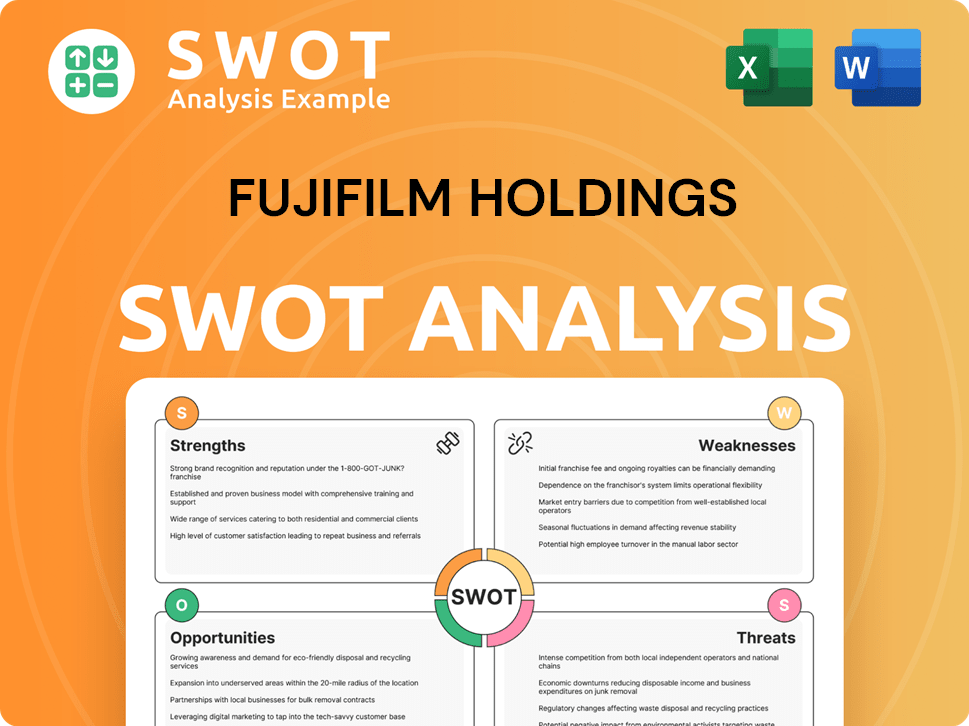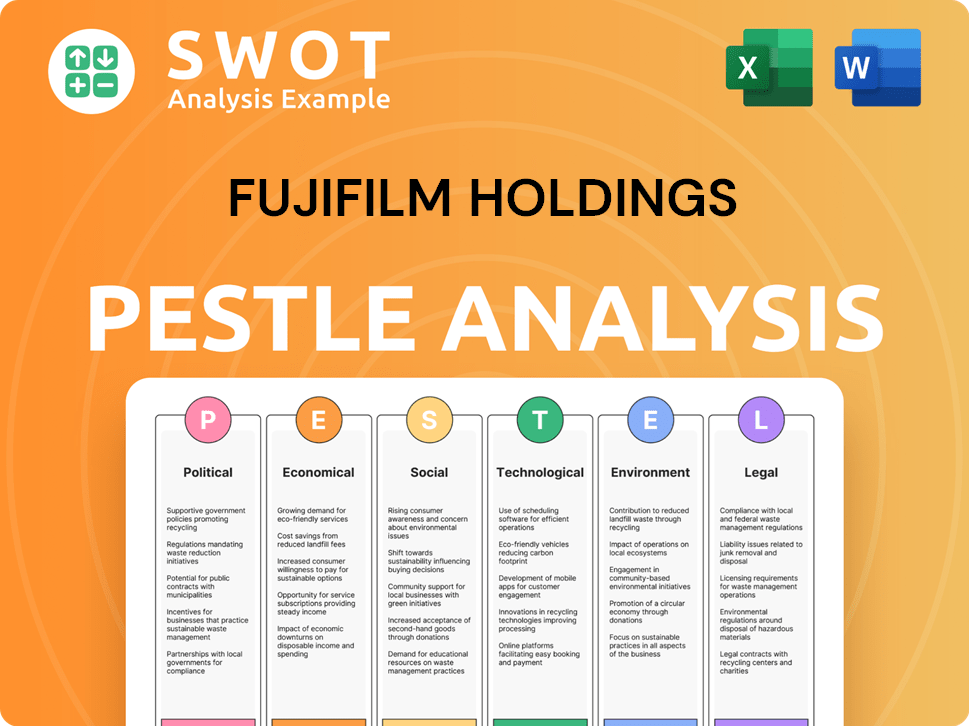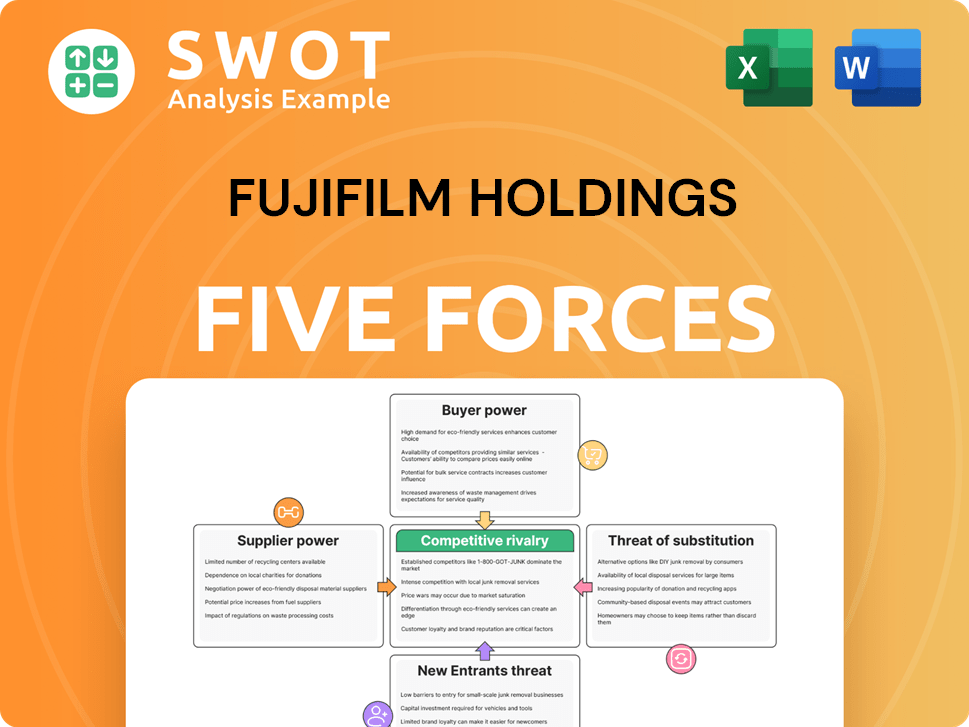Fujifilm Holdings Bundle
How Has Fujifilm Transformed Itself?
From its roots in photographic film, Fujifilm Holdings has remarkably evolved into a global leader across diverse sectors. Witnessing record-breaking financial results, including a revenue of ¥3,195.8 billion for the fiscal year ended March 31, 2025, the Fujifilm company showcases an impressive ability to adapt and innovate. Its strategic shift has positioned it as a diversified powerhouse in healthcare, materials, and imaging solutions.

This article dives into the intricate workings of Fujifilm, exploring its Fujifilm Holdings SWOT Analysis, core operations, and financial performance. Understanding the Fujifilm business model, from its Fujifilm products to its subsidiaries, is key for investors and industry watchers. We'll dissect how Fujifilm makes money, its corporate structure, and its future outlook, providing a comprehensive view of this innovative company and its competitive landscape.
What Are the Key Operations Driving Fujifilm Holdings’s Success?
Fujifilm Holdings operates through a diversified business model, creating value across several key segments. These include Healthcare, Electronics, Business Innovation, and Imaging Solutions. This structure allows the Fujifilm company to leverage its core technologies and expertise across different markets, driving innovation and growth.
The company's value proposition lies in its ability to transform core technologies from its traditional imaging business into high-growth areas like healthcare and advanced materials. This diversification strategy allows Fujifilm Holdings to meet varied customer needs and maintain a competitive edge. The company's strategic partnerships and investments in research and development further strengthen its position in the market.
Fujifilm's operational approach emphasizes manufacturing, technology development, and a robust supply chain. The company's focus on innovation, particularly in photosensitive materials, enables it to develop unique products and solutions across its business segments. This approach is supported by strategic collaborations and investments in key areas, ensuring sustained growth and market relevance.
The Healthcare segment provides medical systems, pharmaceuticals, and Bio CDMO services. The ECHELON Smart ZeroHelium MRI system, launched in April 2024, has performed well. New large-scale Bio CDMO facilities in Denmark began operations in November 2024, with a North Carolina site scheduled for the third quarter of fiscal 2025.
The Electronics segment focuses on semiconductor materials and advanced functional materials. In June 2024, Fujifilm established the Advanced Functional Materials division. This division integrates display materials, industrial products, and fine chemicals businesses, supporting growth in key technology areas.
The Business Innovation segment offers digital transformation solutions and multifunctional printers. The Imaging Solutions segment includes consumer and professional imaging products, such as the 'instax' instant photo systems and digital cameras. These segments contribute significantly to Fujifilm's diverse portfolio.
Fujifilm has a 10-year manufacturing agreement with Regeneron Pharmaceuticals, valued at over US$3 billion. A joint venture with Konica Minolta Inc. for procurement strengthens its operations and supply chain. These partnerships are crucial for sustained innovation and market expansion.
Fujifilm's success is driven by its ability to transition core technologies into new growth areas. This diversification strategy allows the company to adapt to market changes. For more information on the company's strategic approach, see this article about the Marketing Strategy of Fujifilm Holdings.
- Strong R&D capabilities in photosensitive materials.
- Strategic partnerships to strengthen operations and supply chains.
- Focus on innovation across diverse business segments.
- Commitment to expanding into high-growth markets like healthcare.
Fujifilm Holdings SWOT Analysis
- Complete SWOT Breakdown
- Fully Customizable
- Editable in Excel & Word
- Professional Formatting
- Investor-Ready Format

How Does Fujifilm Holdings Make Money?
Understanding the revenue streams and monetization strategies of Fujifilm Holdings is crucial for investors and stakeholders. The company's financial performance is driven by a diverse portfolio of businesses, each contributing significantly to its overall revenue. This diversified approach allows Fujifilm Holdings to navigate market fluctuations and capitalize on growth opportunities across various sectors.
Fujifilm Holdings generates revenue through product sales, service offerings, and contract manufacturing. The company's strategic focus on innovation and technological advancements enables it to maintain a competitive edge and capture market share. The company’s business model is designed to leverage its core competencies in imaging, healthcare, electronics, and business innovation.
For the fiscal year ending March 31, 2025, Fujifilm Holdings reported consolidated revenue of ¥3,195.8 billion. The company's ability to adapt and innovate has been a key factor in its financial success. For a more detailed look at the company's origins, consider reading Brief History of Fujifilm Holdings.
The Healthcare segment is a major revenue driver for Fujifilm Holdings. In the fourth quarter of fiscal 2024, revenues reached ¥310 billion, marking a 9% year-over-year increase. Key contributors include Medical Systems and Bio CDMO.
The Electronics segment saw revenues of ¥106.6 billion in the fourth quarter of fiscal 2024, up 3.9% year-over-year. This growth was fueled by strong demand for semiconductor materials and advanced functional materials. The company anticipates Electronics revenues of ¥420 billion for fiscal 2025.
The Business Innovation Solutions segment recorded revenues of ¥336.5 billion, a 6% increase from the prior-year quarter. Business and Office solutions contributed to this growth. Fujifilm Holdings projects Business Innovation revenues to reach ¥1,220 billion for fiscal 2025.
The Imaging Solutions segment's revenues were ¥115.3 billion, up 14.1% year-over-year. This growth was driven by strong sales of instant photo systems and digital cameras. The company expects Imaging Solutions revenues to be ¥540 billion for fiscal 2025.
Fujifilm Holdings monetizes its offerings through product sales, services, and contract manufacturing. The company leverages its technological advancements in medical systems, highly functional materials, and imaging. The Bio CDMO business, with significant long-term agreements, like the over US$3 billion deal with Regeneron Pharmaceuticals, is a key component.
Fujifilm Holdings is focused on innovation and expansion across its core segments. The company's strategic investments in research and development, coupled with its diversified revenue streams, position it for sustained growth. The company is expected to continue its strong financial performance in fiscal 2025.
Fujifilm Holdings PESTLE Analysis
- Covers All 6 PESTLE Categories
- No Research Needed – Save Hours of Work
- Built by Experts, Trusted by Consultants
- Instant Download, Ready to Use
- 100% Editable, Fully Customizable

Which Strategic Decisions Have Shaped Fujifilm Holdings’s Business Model?
The journey of Fujifilm Holdings has been marked by significant milestones and strategic pivots, shifting from a photographic film manufacturer to a diversified global technology company. A pivotal move was the aggressive diversification into healthcare and advanced materials as the demand for traditional film declined due to digitization. The company's evolution reflects its ability to adapt and innovate, which is central to its Fujifilm business model.
In April 2024, Fujifilm formulated a specific action plan to accelerate growth in Healthcare and Electronics, aligning with its 'Sustainable Value Plan 2030 (SVP2030)' which sets long-term goals for sustainable growth. This strategic focus underscores Fujifilm's commitment to sustainable business practices and long-term value creation. The company's ability to repurpose and evolve its core technologies, initially developed for photographic film, into new applications in healthcare and advanced materials, is a key differentiator.
The company's strategic moves and competitive advantages are crucial for understanding its operational structure. To learn more about their growth strategy, you can read about the Growth Strategy of Fujifilm Holdings.
Notable product launches and market entries include the ECHELON Smart ZeroHelium superconducting MRI system in April 2024, and the upcoming ECHELON Synergy ZeroHelium wide-bore 1.5 Tesla model in June 2025, bolstering its medical systems portfolio. In the Bio CDMO business, the first phase expansion at its Denmark site commenced operations in November 2024, and production at its North Carolina site is set to begin in the third quarter of fiscal 2025, significantly expanding its manufacturing capabilities for biologics.
The company signed a 10-year manufacturing agreement with Regeneron Pharmaceuticals for antibody drugs, valued at over US$3 billion. Operationally, Fujifilm established the Advanced Functional Materials division in June 2024, integrating its display materials, industrial products, and fine chemicals businesses to maximize profitability in the Electronics segment. In January 2025, a joint venture with Konica Minolta Inc., Global Procurement Partners Corp., was established to collaborate on procurement, aiming to build a leading supply structure in the industry.
Fujifilm's competitive advantages stem from its strong brand strength, technological leadership, and continuous innovation. This adaptability is crucial in responding to market challenges, such as fluctuating demand or technological disruption. For instance, in response to potential U.S. tariff policies, Fujifilm is reevaluating its supply chain, reducing costs, and revising product and pricing strategies to minimize impacts.
The company also maintains a commitment to under-manufacturing rather than over-manufacturing, which helps maintain product value. Fujifilm is constantly innovating, as seen in the development of new products and the expansion of its business into new areas. The company's ability to adapt to changing market conditions is a key factor in its long-term success.
Fujifilm's financial performance is closely tied to its strategic initiatives and market conditions. The company's focus on healthcare, advanced materials, and imaging solutions contributes to its revenue streams. The company's commitment to under-manufacturing helps maintain product value and supports its financial outlook. The company's ability to navigate market challenges and technological disruptions is critical for its future financial performance.
- The Bio CDMO business expansion in Denmark and North Carolina is expected to significantly increase manufacturing capacity for biologics.
- The joint venture with Konica Minolta Inc. aims to build a leading supply structure.
- The company's response to potential U.S. tariff policies includes supply chain reevaluation and cost reduction measures.
- The company's commitment to under-manufacturing helps maintain product value.
Fujifilm Holdings Business Model Canvas
- Complete 9-Block Business Model Canvas
- Effortlessly Communicate Your Business Strategy
- Investor-Ready BMC Format
- 100% Editable and Customizable
- Clear and Structured Layout

How Is Fujifilm Holdings Positioning Itself for Continued Success?
Fujifilm Holdings maintains a robust market position across its diverse segments, striving for global leadership in key areas. The company's strategic initiatives and innovation roadmap are geared towards sustaining and expanding its profitability. This includes significant investments in research and development and a focus on digital transformation to enhance customer engagement.
Despite its strengths, Fujifilm faces certain risks, including the potential impact of U.S. tariff policies and the capital-intensive nature of its Bio CDMO business. The company is also navigating strong global competition and the potential for extended free operating cash flow deficits. However, Fujifilm is actively mitigating these risks through strategic planning and operational adjustments.
In the medical imaging sector, the Fujifilm company holds approximately 15% market share and aims to increase this to 20% by 2024. The Imaging and Electronics segments have shown strong performance, contributing to record sales and operating profit in the first half of fiscal year 2024. This demonstrates the company's ability to adapt and excel in various markets.
U.S. tariff policies could lead to an estimated overall operating income loss of USD140 million for fiscal year 2025. The capital-intensive nature of the Bio CDMO business and strong global competition in facility expansion present risks to operational stability. Extended free operating cash flow deficits due to substantial capital investments could increase reliance on debt, impacting the Fujifilm business model.
The 'VISION2030' medium-term management plan aims for global revenue of ¥4 trillion (approximately US$29 billion) by FY2030. Fujifilm plans to invest approximately ¥100 billion (around US$910 million) in research and development for fiscal year 2024. The company is investing ¥170 billion in capital expenditure and R&D over the three years up to fiscal year ending March 2027.
Fujifilm's commitment to digital transformation includes a planned investment of ¥30 billion (about US$273 million) by the end of 2024 to improve customer engagement. For the fiscal year ending March 2026, Fujifilm aims to set new record highs with a projected revenue of ¥3,280 billion and an operating income of ¥331 billion. This underscores the Fujifilm Holdings commitment to innovation and growth.
Fujifilm is focusing on strategic investments and innovation to drive future growth. The company's commitment to R&D and capital expenditure reflects its long-term vision and dedication to market leadership. These initiatives aim to enhance profitability and operational performance.
- Investments in R&D for advanced imaging and healthcare technologies.
- Expansion of global supply structure, particularly in semiconductor materials.
- Digital transformation to improve customer engagement.
- Targeting record revenue and operating income for fiscal year ending March 2026.
Fujifilm Holdings Porter's Five Forces Analysis
- Covers All 5 Competitive Forces in Detail
- Structured for Consultants, Students, and Founders
- 100% Editable in Microsoft Word & Excel
- Instant Digital Download – Use Immediately
- Compatible with Mac & PC – Fully Unlocked

Related Blogs
- What are Mission Vision & Core Values of Fujifilm Holdings Company?
- What is Competitive Landscape of Fujifilm Holdings Company?
- What is Growth Strategy and Future Prospects of Fujifilm Holdings Company?
- What is Sales and Marketing Strategy of Fujifilm Holdings Company?
- What is Brief History of Fujifilm Holdings Company?
- Who Owns Fujifilm Holdings Company?
- What is Customer Demographics and Target Market of Fujifilm Holdings Company?
Disclaimer
All information, articles, and product details provided on this website are for general informational and educational purposes only. We do not claim any ownership over, nor do we intend to infringe upon, any trademarks, copyrights, logos, brand names, or other intellectual property mentioned or depicted on this site. Such intellectual property remains the property of its respective owners, and any references here are made solely for identification or informational purposes, without implying any affiliation, endorsement, or partnership.
We make no representations or warranties, express or implied, regarding the accuracy, completeness, or suitability of any content or products presented. Nothing on this website should be construed as legal, tax, investment, financial, medical, or other professional advice. In addition, no part of this site—including articles or product references—constitutes a solicitation, recommendation, endorsement, advertisement, or offer to buy or sell any securities, franchises, or other financial instruments, particularly in jurisdictions where such activity would be unlawful.
All content is of a general nature and may not address the specific circumstances of any individual or entity. It is not a substitute for professional advice or services. Any actions you take based on the information provided here are strictly at your own risk. You accept full responsibility for any decisions or outcomes arising from your use of this website and agree to release us from any liability in connection with your use of, or reliance upon, the content or products found herein.